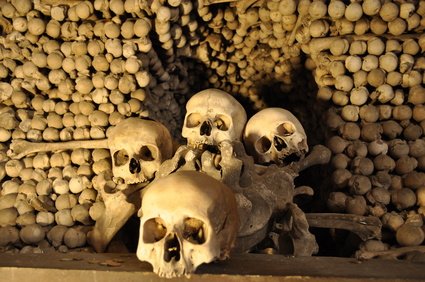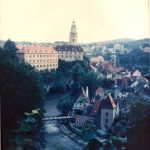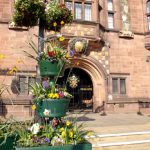 John M. Edwards mispronounces the naughty-sounding destination “Kutna Hora” at a train station in Prague, a surreal stage set straight out of the Quentin Tarantino/Eli Roth shocker “HOSTEL,” set in Slovakia but filmed in the Czech Republic. . . .
John M. Edwards mispronounces the naughty-sounding destination “Kutna Hora” at a train station in Prague, a surreal stage set straight out of the Quentin Tarantino/Eli Roth shocker “HOSTEL,” set in Slovakia but filmed in the Czech Republic. . . .
At Hlavni Nadrazi, Prague’s main train station, the large ugly lady in Aeroflot chic flinched when I ordered a roundtrip to the naughty-sounding “Kutna Hora,” mispronouncing my destination on purpose. She blinked rapidly like the flipping of a train schedule board, or a deck of Tarot Cards, acting as if I had just called her “Cunt Whore”!
But at last getting it, the female factotum handed me my ticket as if it were toilet tissue to clean myself up, which you still have to pay for in WCs (waterclosets) in the Czech Republic, a holdover from Communist times. I wanted to go to a small picaresque village in order to get some. Not prostitution, mind you, but a chance encounter with a Eurotrash model with high Slavic cheekbones, where an American backpacker might still be a novelty, away from overcrowded Prague and its subversive stag and hen parties.
There are a lot of things in life that make no sense, such as mambypamby “daytrips”—why not stay overnight? The less time we spend in a place the more likely we are in giving it an unfair decree of a Holy Roman Emporer’s thumb’s down and disparaging comment: “Suuucks!”
But I wanted to see what many people consider to be the most “picturesque” small village in the Czech Republic, although in its heyday this devilish demesne was so rich that they had their own mint.
What’s more, one of Europe’s most gruesome sites lies nearby: the Sedlec Ossuary (bone chapel). Pictures I had seen of it were reminiscent of Medieval wood cuts of The Grim Reaper or skeletal Tarot Cards or Grateful Dead stickers, all skulls and crossbones. Although a grim reminder that none of us have all that long in the world, this Christian chapel of bones was not used for satanic rights but instead their opposite.
Within the geographic region actually called “BOHEMIA” on a map, Kutna Hora sounds like a set for the Indiana Jones flicks and is filled with real Bohemians, where the now near-universal term for “vagabond” comes from: artists, intellectuals, musicians, flaneurs, as well as dirtbag backpackers.
Kutna Hora was a silver mining town in Medieval times, with, I must reiterate, its own mint, and today the Historical Town Center is a UNESCO World Heritage Site. The Cathedral of St. Barbara, begun by Peter Parler in 1380, and The Cathedral of Our Lady at Sedlec, built I dunno when, are the two standout churches. Throughout the city, though, are restored Medieval, Gothic, Renaissance, and Baroque facades often disguising urban decay inside.
Other sights include all the silver mines, many tours of which begin at Hradek, the Czech museum of silver, and the Royal Mint and former Royal Residence on the so-called Italian Courtyard. Also, don’t forget to visit the Alchemy Museum in the Sankturin House and The Torture Museum. Especially, if you are a fan of Quentin Tarantino’s and Eli Roth’s shocker “HOSTEL,’ which even though it is supposedly set in Slovakia was filmed instead here in the Czech Republic.
At the U Hrncire (“By the Jug Maker’s”) I stuck with traditional Czech dishes like pork and peas, washed down with Staropramen “pivo” (pilsener), rather than the well-known exports of Pilsener Urquell and the original Budvar (now called “Czechvar” to avoid confusion with the American “Budweiser”). Grub was so cheap out here that I ordered also a Czech-style ghoulash with dour doughy dumplings.
Now on to the real reason I had come here: to contemplate death, for only forty Czech korunas (crowns).
Open every day, except for Christmas, the Sedlec Ossuary (Kostnice, Zamecki 127) dates back to 1278 when Jindrich, the abbot of Sedlec, was sent to the Holy Land and returned with soil from Golgotha and sprinkled it on the land. In 1511 a chapel was constructed containing the bones from abolished graves, over 40,000 of them, many of them victims of the Thirty Years War in the 17th Century. The artist Frantisek Rint in 1870 rearranged the bones in an artistic manner, including an enormous chandelier with every bone of the body and a crucifix-style configuration near the main altar.
According to legend, partially blind mad monks started arranging the bones into geometric shapes. However, the decorations and sculptures were created by the master wood-cutter and architect Frntisek Rint who began his skullduggery literally in 1870 to drive home the impermanence of life and the inevitability of death. Rint’s specialty was skull candelabra, but his patrons, the wealthy Schwarzenberg Family, also requested a royal coat of arms with a raven pecking out the eyes of a woebegone invading soldier.
Macabre?
Nope, downright “creepy”!
For more info, visit the official Kutna Hora website www.kutnahora.cz







Leave a Reply